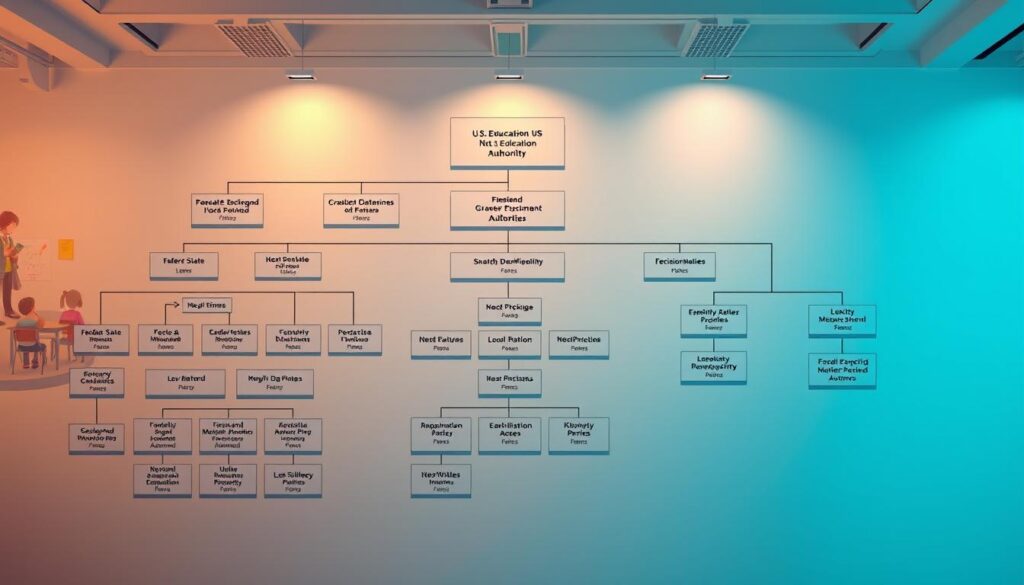The landscape of education in the United States is constantly evolving, shaped by various factors including governance and policy decisions.
The education policy in the US is a complex system that affects millions of students, teachers, and schools across the country. Understanding this system is crucial for anyone concerned about the future of American education.
As we explore the current state and future directions of US education policy, we’ll examine how policy is formed, implemented, and evaluated at different levels. This includes looking at the historical context, key stakeholders, and research that inform policy decisions.
By understanding the intricacies of education systems and governance, we can better appreciate the challenges and opportunities facing schools and the broader American society.
Table of Contents:
- The Landscape of US Education Policy
- Governance Structure of Education Policy in America
- Current Education Policy Frameworks
- Key Issues in Education Policy
- Teacher Policy and Professional Development
- Equity and Access in Education Policy
- Future Directions in US Education Policy
- Conclusion: Shaping the Future of American Education
The Landscape of US Education Policy
The landscape of US education policy is shaped by a myriad of laws, regulations, and policy decisions. Education policy encompasses the principles, laws, and regulations that govern how educational systems operate and what they aim to achieve in the United States. It is a complex field, influenced by various stakeholders and levels of governance.
Definition and Scope of Education Policy
Education policy consists of the principles and policy decisions that influence the field of education, as well as the collection of laws and rules that govern the operation of education systems. The scope is broad, covering everything from curriculum standards and teacher certification to school funding formulas and accountability measures. Effective education policy is crucial for ensuring that educational systems meet the needs of students and society.
Some analysts view education policy in terms of social engineering, aiming to address societal issues through educational reform. Understanding the definition and scope of education policy provides a foundation for analyzing its impact and effectiveness.
Historical Context and Evolution
The historical context of US education policy is marked by significant developments, from the early public school movement to landmark legislation such as the Elementary and Secondary Education Act. Over time, educational policy has shifted between periods of centralization and decentralization, reflecting changing political and social priorities.
Research and analysis have played crucial roles in shaping education policy, influencing how we understand and evaluate educational systems. By examining the historical evolution of education policy, we can better understand current issues and predict future trends in American education.
Governance Structure of Education Policy in America
The governance of education in the US is distributed across various levels of government, creating a complex system that is unique compared to other OECD countries. This decentralized approach gives significant autonomy to state and district levels, reflecting the American emphasis on individual rights and a cautious approach to federal overreach.
Federal Role in Education
The federal government, through the Department of Education, plays a crucial role in setting broad policies, providing funding, and enforcing civil rights laws. However, it has limited direct control over educational practices, allowing for significant variability across states.
State Authority and Responsibilities
Under the Tenth Amendment, state governments hold primary authority for education, establishing standards, providing the majority of funding, and setting teacher certification requirements. This results in a diverse landscape of education policies across different states, with each state tailoring its approach to its specific needs and priorities.

Local Control and School Districts
Local school districts are the most direct level of educational governance, with elected school boards making key decisions about curriculum, budgets, and personnel. This local control enables districts to respond to the unique needs of their communities, but can also lead to inconsistencies in educational quality and equity.
The interplay between federal, state, and local authorities creates a “tangled web” of overlapping authorities and competing priorities, making education reform challenging. Understanding this complex governance structure is essential for addressing the complexities of US education policy.
Current Education Policy Frameworks
Understanding the current education policy landscape requires examining the roles of federal and state governments in shaping educational standards and practices. Over the past 30 years, there has been a steady increase in government involvement in US schools at both state and federal levels.
Major Federal Education Legislation
The Every Student Succeeds Act (ESSA), enacted in 2015, is a landmark federal legislation that replaced No Child Left Behind. ESSA establishes requirements for standards, assessment, and accountability while giving states more flexibility in implementation. This shift represents a significant change in the education system, allowing for more state autonomy in education policies.
- Federal laws set the framework for education reform efforts nationwide.
- ESSA provides a balance between federal oversight and state flexibility.
State-Level Policy Variations
State-level policies vary widely, with some states adopting common standards like the Common Core, while others develop their own unique academic standards and assessment systems. States also implement different approaches to teacher evaluation, school choice programs, and funding formulas within the broader federal framework.
- States have flexibility in implementing federal education laws.
- Different states have different approaches to education reform.
The interplay between federal requirements and state autonomy shapes reform efforts across the country. Understanding these frameworks is essential for educators, administrators, and policymakers working within the system and advocating for meaningful reform.
Key Issues in Education Policy
The landscape of US education policy is complex, with several key issues at the forefront of current debates. These issues are multifaceted and impact various aspects of the education system, from school funding to educational achievement.
School Funding and Resource Allocation
School funding remains a contentious issue, with significant disparities between wealthy and poor districts affecting resource allocation and educational opportunities. Public schools are funded through a combination of local property taxes, state formulas, and federal programs, creating inequities that impact student achievement. As many American families struggle to pay for school meals, it’s clear that funding models need reevaluation to ensure equitable access to resources.
Standardized Testing and Accountability
Standardized testing continues to be a central component of accountability systems, though there is ongoing debate about its effectiveness and potential negative consequences for teaching and learning. The emphasis on testing raises questions about its impact on accountability and whether it truly measures student potential. Critics argue that it can lead to teaching to the test, rather than fostering a deeper understanding of the subject matter.
“The over-reliance on standardized testing has led to a narrow curriculum, where subjects not tested are often marginalized.”
School Choice and Privatization
The school choice movement has expanded significantly, with policies supporting charter schools, voucher programs, and other alternatives to traditional public schools. While proponents argue that school choice increases competition and improves educational outcomes, critics raise concerns about the potential for increased segregation and inequity. The impact of these policies on public schools and students is a critical area of ongoing research and debate.
Understanding these key issues in education policy is crucial for contextualizing current reform efforts and the competing visions for improving educational outcomes for all students. By examining the intersections of funding, testing, and school choice, we can better understand how to improve access to quality education across the United States.
Teacher Policy and Professional Development
A well-crafted teacher policy is fundamental to ensuring that all students have access to high-quality educators. Teacher policy encompasses various aspects, including preparation, recruitment, support, and evaluation of teachers throughout their careers. “The quality of an education system cannot exceed the quality of its teachers,” as emphasized by various education experts. Effective teacher policy is guided by a strategic, holistic, and context-sensitive approach.
Teacher Recruitment and Retention
Teacher recruitment and retention are critical challenges facing many school districts. Approximately 8% of teachers leave the profession annually, resulting in significant costs and disruptions. To address this, districts are implementing innovative recruitment strategies and improving teacher retention through better working conditions and support systems. Retaining effective teachers is as crucial as recruiting them.
Teacher Education and Continuing Development
Teacher education and continuing professional development are vital for ensuring that educators are equipped to meet evolving classroom demands. Teacher preparation programs are adapting to incorporate new teaching methodologies and technologies. Moreover, ongoing professional development opportunities help teachers stay updated with best practices. Continuous learning is key to a teacher’s success.
Teacher Evaluation and Accountability
Teacher evaluation systems have become more sophisticated, incorporating multiple measures such as student achievement data and peer review. These systems aim to provide a comprehensive assessment of teacher performance, helping to identify areas for improvement and inform professional development opportunities. Accountability in teacher evaluation is crucial for maintaining high educational standards.
Equity and Access in Education Policy
Equity and access have emerged as critical components in shaping the future of US education policy. Ensuring that all students have equal opportunities to succeed is a complex challenge that involves addressing various systemic barriers. Education policies are being reformed to promote equity and access, focusing on the diverse needs of students across different communities.
Addressing Systemic Inequalities
Systemic inequalities significantly impact education outcomes, with achievement gaps persisting based on race, socioeconomic status, disability status, and English language proficiency. To address these disparities, policies are being implemented to provide targeted support. Data collection and analysis play a crucial role in identifying and understanding these gaps, enabling policymakers to develop informed interventions.

Policies for Underserved Communities
Policies aimed at supporting underserved communities include targeted funding formulas, intervention programs, and community schools. These initiatives are designed to address both academic and non-academic barriers to learning, ensuring that all students have the resources they need to succeed. By focusing on access to quality education and schools, these policies help bridge the gap for disadvantaged populations.
Gender and Cultural Considerations
Gender and cultural considerations are also vital in promoting equity in education. Policies are being developed to address disparities in STEM participation, support pregnant and parenting students, and create safe learning environments free from gender-based harassment. Additionally, incorporating cultural responsiveness into curriculum standards and teacher preparation helps ensure that education is inclusive and relevant to diverse student populations.
Future Directions in US Education Policy
Emerging trends and technological advancements are redefining the landscape of US education policy. As we look to the future, it’s clear that education will continue to play a vital role in shaping the nation’s prosperity.
Emerging Policy Trends
The US education system is witnessing a shift towards more personalized learning approaches, with a focus on social-emotional learning and competency-based education models. Emerging policy trends also include increased attention to workforce preparation and innovative school models.
- Increased focus on social-emotional learning
- Workforce preparation and vocational training
- Innovative school models and alternative credentialing systems
Technology and Digital Learning Policies
Technology is transforming the education landscape, with digital learning becoming increasingly prevalent. Policies are evolving to address digital equity concerns, online learning quality, data privacy, and the integration of artificial intelligence in education.
Post-Pandemic Policy Shifts
The COVID-19 pandemic has accelerated certain policy trends while creating new priorities around learning recovery, mental health support, and educational continuity during disruptions. The future of US education policy will be shaped by these post-pandemic shifts, with a focus on innovation and resilience.
Conclusion: Shaping the Future of American Education
The future of American education depends on our ability to navigate the complexities of education policy. As we’ve seen, the US education system is influenced by a multitude of factors, including federal, state, and local policies.
To drive meaningful education reform, it’s essential to adopt evidence-based approaches that consider both research findings and contextual realities. This requires collaboration among policymakers, educators, researchers, families, and communities to shape effective policy.
By keeping students at the center of policy discussions and focusing on how policies affect learning experiences and outcomes, we can create a more equitable and effective education system. The United States can learn from its own policy experiences and international examples, adapting approaches to fit American contexts and values.
Ultimately, shaping the future of American education requires thoughtful engagement with education policy issues, recognizing their profound importance for individual students, teachers, and the nation as a whole.

